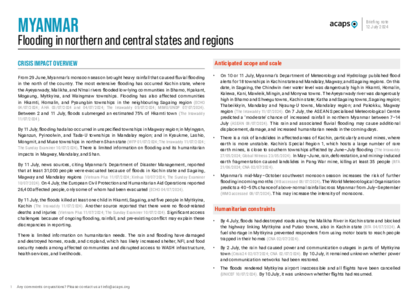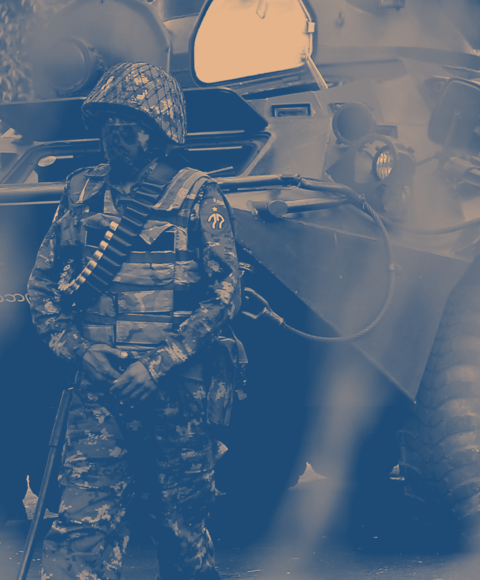Latest updates on country situation
05 March 2025
Healthcare needs in Myanmar are on the rise, particularly in the northwestern region. Since the acute watery diarrhoea outbreak in June 2024, nine states out of 17 have reported outbreaks of water- and vector-borne diseases. Clean water, medicine, and vaccine shortages have worsened the situation. In 2025, it is estimated that 12.9 million people will need healthcare assistance, while 1.2 million unvaccinated children under five are at high risk for vaccine-preventable diseases. Restrictions imposed by the military junta on transportation have aggravated the scarcity of medical supplies, particularly in Chin and Rakhine states and in Sagaing region. The number of displaced people in these regions is also increasing. Rakhine and Sagaing account for over 1.5 million of Myanmar’s 3.2 million IDPs. The US funding freeze is worsening the crisis, as it severely limits the ability of humanitarian organisations to deliver lifesaving health assistance to those in urgent need. With the rainy season approaching, conditions are expected to deteriorate even further. (WHO 28/02/2025, RFA 28/02/2025, UNHCR 18/02/2025)
04 February 2025
Intense armed clashes between anti-junta armed groups and military junta forces, as well as raids conducted by the latter, have displaced around 26,000 residents of Pwintbyu and Salin townships in Magway region since late January 2025. The new displacements will likely take the number of IDPs in the region to around 275,000. Significant damage to homes has been reported, with the newly displaced people living in makeshift shelters. Harvested rice crops in some areas have also been destroyed. This will heighten the shelter and food security needs in the region. Based on previous displacement events, the newly displaced people will likely urgently require food, water, health, protection assistance, shelter, and household items. Armed conflict, movement and administrative restrictions, the obstruction of humanitarian operations, and violence against aid workers highly constrain humanitarian access in Myanmar. Transportation restrictions also hinder the delivery of essential services and disrupt the supply chain. (RFA 03/02/2025, Myanmar NOW 03/02/2025, UNHCR 31/01/2025)
02 January 2025
Since 2022, around 15,900 Rohingya people have attempted to undertake dangerous maritime journeys in over 190 overcrowded and unseaworthy vessels – nearly 50% of which embarked just within 2024 (until 19 December) – from Myanmar or Bangladesh in hopes of reaching other countries, such as Malaysia and Indonesia. Over 1,400 have died or gone missing, 50% in 2024 alone. Nearly 95% of the vessels that undertook the journeys in 2024 embarked from Rakhine state, from where the Rohingya are fleeing to escape intense armed conflict and violence, forced recruitment, high food insecurity levels, and severe access restrictions. These people need food, water, healthcare, and protection during and after their journeys. Such journeys are likely to increase in the coming months given non-monsoon weather conditions, a trend that has been observed in previous years. (UNHCR accessed 02/01/2025, UNHCR 05/11/2024, OCHA 13/12/2024)
17 December 2024
15.2 million people in Myanmar are facing acute food insecurity, with 2.3 million classified to be facing Emergency (IPC Phase 4) conditions. The majority reside in Chin, Kachin, and Rakhine states and Sagaing region. The main drivers are intense and widespread conflict, economic collapse, and recurring natural hazards. Extreme levels of humanitarian constraints, such as violence against humanitarian personnel, facilities, and assets; interference with humanitarian implementation; the denial of the degree of the crisis, including by restricting the collection and publication of food insecurity data and analysis; and administrative and physical impediments to reaching people in need significantly aggravate the situation. The affected people urgently require emergency food assistance. (Humanitarian Action 12/12/2024, Reuters 16/12/2024, ACAPS accessed 18/12/2024)
19 November 2024
Insecurity and armed conflict in Rakhine state have reached a historic high. By mid-November 2024, the number of reported fatalities had surpassed the combined figure for the previous ten years. The number of IDPs had also reached around 530,000, 15% of the state’s estimated population of 3.6 million. Those residing in Rakhine are facing widespread food insecurity, as rice production has significantly fallen, the cost of food has increased, and there is widespread unemployment and a lack of a social safety net, limiting purchasing power. There are also severe restrictions on humanitarian access and a lack of access to essential services. In 2024, there has been a significant uptick in cross-border displacements and dangerous maritime journeys among the Rohingya attempting to reach other countries, indicating the severity of the humanitarian situation in Rakhine. (UNDP 07/11/2024, UNHCR accessed 20/11/2024, ACLED accessed 20/11/2024)
12 November 2024
Since July 2024, heavy monsoon rains and the remnants of Typhoon Yagi have resulted in intense flooding that has significantly heightened the humanitarian needs in Myanmar. The floods have destroyed around 3,000 houses and damaged 36,000, which currently need repair. The most flood-affected areas include the regions and states in the northwest and southeast, as well as Rakhine state. (Shelter Cluster 08/11/2024)
08 October 2024
The Myanmar military junta has increased airstrikes in Lashio town. Out of a population of 250,000, around 200,000 have fled to other towns in Shan state (such as Kalaw, Nyaung Shwe, and Taunggyi) and main cities of other regions such as Mandalay. The people of Lashio town are experiencing recurrent displacements caused by the fighting. Based on previous displacements, IDPs would need urgent shelter, food, potable water, protection, healthcare support (especially psychosocial support), and access to WASH facilities and items. People who are currently residing in Lashio are facing heightened protection concerns. The humanitarian response in the town is hindered by airstrikes and a telecommunications and internet blackout. Many humanitarian organisations have suspended their operations or evacuated from Lashio earlier in 2024 because of insecurity. Fighting in the town has already resulted in significant casualties and damage and destruction to civilian infrastructure such as homes and offices. Media reports suggest that a possible future ground offensive by the junta to recapture the town is imminent. (ECHO 03/10/2024, RFA 02/10/2024, BNI 07/10/2024)
current crises
in
Myanmar
These crises have been identified through the INFORM Severity Index, a tool for measuring and comparing the severity of humanitarian crises globally.
MMR004 - Post-coup conflict
Last updated 26/02/2025
Drivers
Violence
Socio-political
Conflict
Crisis level
Country
Severity level
4.6 Very High
Access constraints
5.0
MMR001 - Country level
Last updated 26/02/2025
Drivers
Socio-political
Conflict
Violence
Crisis level
Country
Severity level
4.6 Very High
Access constraints
5.0
MMR002 - Rakhine conflict
Last updated 26/02/2025
Drivers
Conflict
Crisis level
Country
Severity level
4.1 Very High
Access constraints
5.0
MMR003 - Kachin and Shan conflict
Last updated 26/02/2025
Drivers
Conflict
Crisis level
Country
Severity level
4 High
Access constraints
5.0
REG011 - Rohingya Regional Crisis
Last updated 25/09/2024
Drivers
Crisis level
Regional
Severity level
4.1 Very High
Access constraints
5.0
Analysis products
on
Myanmar
09 January 2025
Myanmar: INFORM Severity Index trends
DOCUMENT / PDF / 3 MB
This report describes the recent changes in the INFORM Severity Index scores of humanitarian crises in Myanmar from January 2021 to July 2024. The selected period covers the military coup in February 2021, which has significantly affected the humanitarian situation in the country.
Attached resources
18 November 2024
Myanmar: access constraints in Rakhine state
DOCUMENT / PDF / 284 KB
This report highlights the challenges surrounding aid delivery for humanitarian organisations and access to that aid for people in need. It aims to inform humanitarian responders, donors, and decision makers about the access constraints affecting their operations, staff, and the communities they serve.
24 September 2024
Myanmar: impact of Typhoon Yagi
DOCUMENT / PDF / 1 MB
This report analyses the multisectoral impact of Typhoon Yagi on affected states and regions in Myanmar, detailing pre-crisis needs and vulnerabilities where information is available. This report also anticipates developments in the coming two–three months and details humanitarian constraints and response capacity.
12 July 2024
Myanmar: Flooding in Kachin
DOCUMENT / PDF / 341 KB
From 29 June, Myanmar’s monsoon season brought heavy rainfall that caused fluvial flooding in the north of the country. The most extensive flooding has occurred Kachin state. At least 31,000 people were evacuated and 26,400 people were reported to be affected by the floods, only some of whom had been evacuated.







